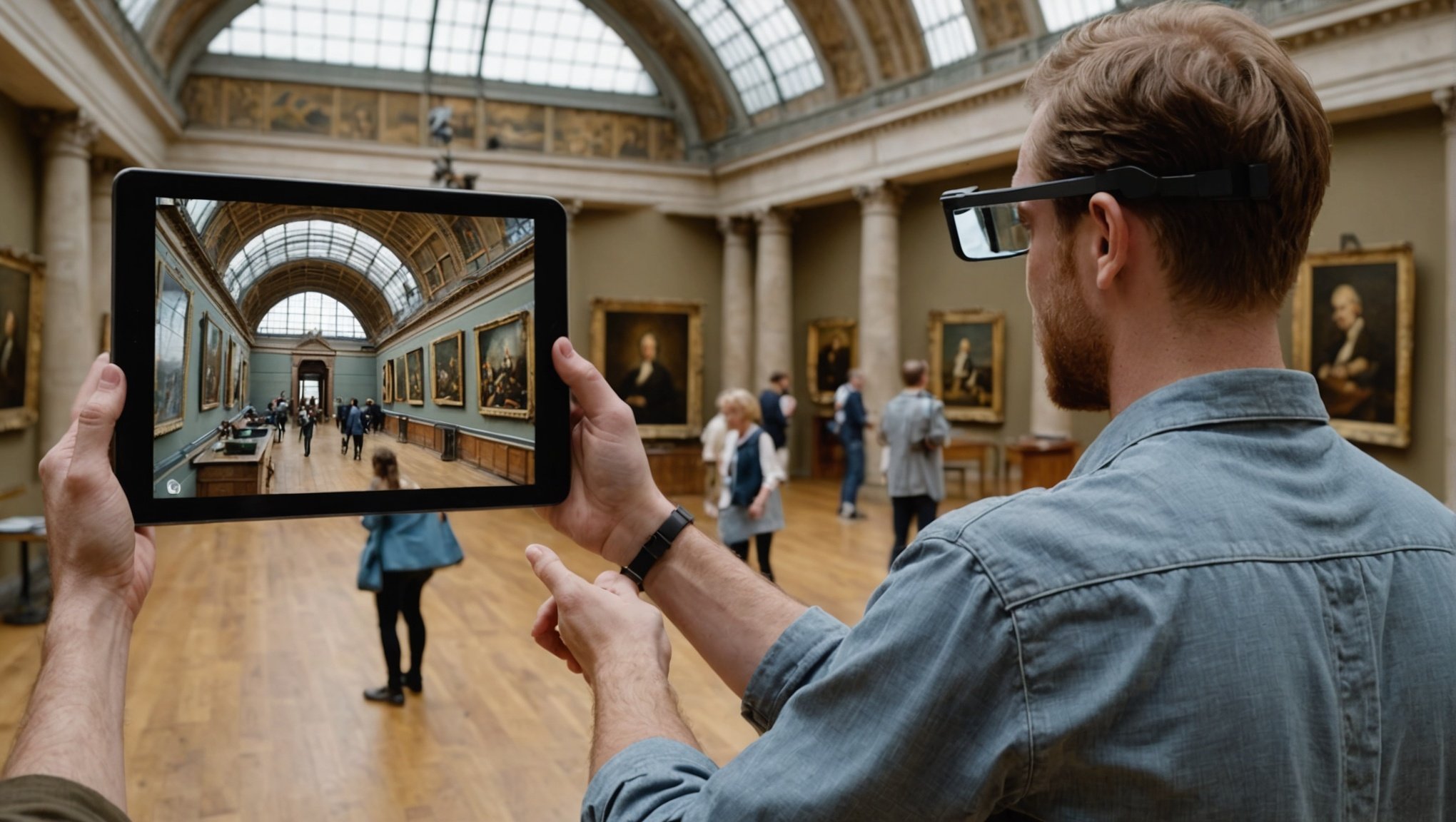As we step into a new era of technological advancements, the museum experience is evolving at a rapid pace, thanks to the advent of augmented reality (AR). In the UK, museums are leveraging this innovative technology to enhance visitor experiences. By integrating AR, museums provide interactive and immersive encounters that bring art, history, and cultural heritage to life in ways that were previously unimaginable. This article will explore how AR is being effectively utilized to transform UK museums, offering visitors unforgettable experiences that enrich their learning and appreciation of the exhibits.
Augmented Reality: Redefining Museum Interactions
Augmented reality is revolutionizing how we perceive and interact with our surroundings. In the context of museums, AR overlays digital information onto the physical world, creating a seamless blend of reality and virtual content. This technology allows visitors to explore exhibits in an interactive manner, making the museum experience both educational and entertaining.
Also to discover : What are the best practices for integrating AI into UK’s recruitment processes?
In the UK, national museums like the British Museum and the Natural History Museum have started implementing AR to enhance visitor engagement. By simply using an app on their smartphones, visitors can view augmented reality elements such as 3D models, videos, and additional information about the exhibits. For example, at the Natural History Museum, visitors can use AR to see a life-sized woolly mammoth come to life right before their eyes. This not only provides a deeper understanding of the exhibit but also makes the learning experience more memorable.
AR can also offer interactive guides that provide personalized tours based on the visitor’s interests. These guides can highlight specific artifacts, provide in-depth information, and even offer quizzes and challenges to keep the visitor engaged. This personalized approach ensures that each visitor has a unique and enriching experience tailored to their preferences.
Also read : How can UK healthcare providers utilize blockchain for secure patient data management?
Enhancing Art Appreciation through Augmented Reality
Art museums and galleries across the UK are embracing AR to offer visitors a new way to appreciate and understand art. AR can provide additional layers of context and storytelling that traditional labels and descriptions cannot match. By using AR, visitors can gain insights into the artist’s techniques, the historical context of the artwork, and even see the creative process behind the masterpiece.
For instance, the Tate Modern in London uses AR to allow visitors to see the layers beneath a painting’s surface, revealing the artist’s preliminary sketches and thought processes. This not only provides a deeper appreciation of the artwork but also brings the creative journey to the forefront. Visitors can also use AR to see how different artworks were restored, witnessing the meticulous work involved in preserving these cultural treasures.
AR can also facilitate immersive experiences that transport visitors into the world of the artwork. For example, an AR app might allow visitors to step inside a Van Gogh painting, experiencing the vibrant colors and swirling brushstrokes firsthand. This level of immersion creates a profound connection between the visitor and the artwork, making the museum visit a truly transformative experience.
Bringing History to Life with Augmented Reality
One of the most powerful applications of AR in museums is its ability to bring history to life. By overlaying historical scenes and events onto the present-day museum environment, AR can transport visitors back in time, providing a firsthand glimpse into the past. This immersive technology makes history tangible and engaging, fostering a deeper understanding and appreciation of our cultural heritage.
At the Imperial War Museum in London, for example, visitors can use AR to see historical battles unfold before their eyes. By pointing their smartphones at specific exhibits, they can witness soldiers marching, hear the sounds of warfare, and read firsthand accounts from those who lived through these events. This interactive experience transforms the museum visit into a journey through time, offering a vivid and emotional connection to history.
Similarly, the Jorvik Viking Centre in York uses AR to recreate Viking-era York, allowing visitors to explore the streets, interact with Viking characters, and learn about their daily lives. This reality technology not only makes the historical content more engaging but also helps visitors retain the information better, as they are actively participating in the learning process.
Educational Opportunities with Augmented Reality
AR offers a wealth of educational opportunities for museums and their visitors. By providing interactive and immersive experiences, AR can enhance museum learning and make it more accessible and enjoyable for people of all ages. This technology can be particularly beneficial for young learners, who can engage with the content in a hands-on and playful manner.
For example, at the Science Museum in London, children can use AR to conduct virtual experiments, explore the inner workings of machines, and even travel through the human body. These augmented reality experiences make complex scientific concepts more understandable and fun, fostering a love for learning and discovery.
AR can also support educational programs and workshops in museums. By integrating AR into their curriculum, educators can provide students with a richer and more dynamic learning experience. For instance, a workshop on ancient Egypt might use AR to let students explore a virtual pyramid, uncovering hidden chambers and learning about the pharaohs and their beliefs. This interactive approach not only enhances learning but also encourages critical thinking and curiosity.
Furthermore, AR can provide valuable resources for scholars and researchers. By using AR to access additional information and digital archives, they can conduct more thorough and efficient research. For example, a Google Scholar integration might allow researchers to access academic papers and studies directly through the AR interface, providing a seamless blend of physical and digital resources.
Future Prospects: The Evolution of Augmented Reality in Museums
As AR technology continues to advance, the possibilities for its application in museums are endless. The future of AR in museums promises even more immersive and interactive experiences that will further enhance visitor engagement and learning. Here are some potential future developments in AR for museums:
Mixed Reality Experiences
The integration of AR with other emerging technologies, such as virtual reality (VR) and mixed reality (MR), will create even more immersive experiences. For example, visitors might use MR headsets to explore a virtual reconstruction of an ancient city, seamlessly blending the physical museum environment with digital content. This hybrid approach will provide a more holistic and engaging museum visit.
Personalized AR Experiences
Advancements in artificial intelligence (AI) and machine learning will enable museums to offer highly personalized AR experiences. By analyzing visitor data and preferences, museums can tailor the AR content to match each visitor’s interests and learning style. This personalized approach will ensure that every visitor has a unique and meaningful experience.
Collaborative and Social AR
Future AR applications will likely incorporate social and collaborative features, allowing visitors to share their experiences and interact with each other. For example, visitors might use AR to collaborate on solving puzzles or challenges, enhancing the social aspect of the museum visit. This collaborative approach will foster a sense of community and shared discovery among visitors.
Enhanced Accessibility
AR can also improve accessibility in museums by providing features such as real-time translation, sign language interpretation, and audio descriptions. These enhancements will make museum content more inclusive and accessible to a broader audience, ensuring that everyone can enjoy and benefit from the museum experience.
The integration of AR in UK museums is revolutionizing the way we experience and engage with art, history, and cultural heritage. By leveraging this immersive technology, museums can provide visitors with interactive and personalized experiences that enhance their understanding and appreciation of the exhibits. Whether it’s bringing historical events to life, offering deeper insights into artworks, or providing educational opportunities, AR is transforming the museum experience into a dynamic and unforgettable journey.
As AR technology continues to evolve, the future of museums looks promising, with even more innovative and immersive experiences on the horizon. By embracing AR, UK museums can ensure that they remain relevant, engaging, and accessible to visitors of all ages and backgrounds. So the next time you visit a museum, be prepared to step into a world where reality and virtual content blend seamlessly, creating an enriching and transformative experience that will leave you inspired and enlightened.











